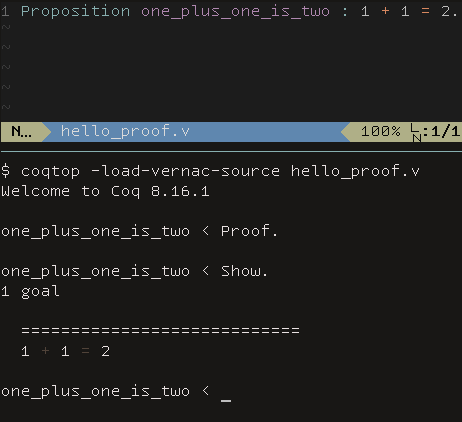Coq is a proof management system that provides a formal language to write mathematical definitions, executable algorithms, and theorems together with an environment for semi-interactive development of machine-checked proofs. This tutorial will guide you through the process of installing Coq on Windows, Mac, and Linux, and then how to write a simple proof using coqtop. coqtop is the Read-Eval-Print Loop (REPL) for Coq. It allows you to interactively develop proofs. If you come from Haskell, you can think of Coq like GHC and coqtop like GHCi.
Installing Coq
-
Installing Coq on Windows
- Download and run the Windows installer from the Coq website (https://coq.inria.fr/download).
-
Installing Coq on Mac
- The easiest way to install Coq on Mac is through Homebrew.
- You can install Coq by running:
brew install coq.
-
Installing Coq on Linux
- For Debian-based distributions like Ubuntu, use apt to install Coq.
sudo apt install coq
- For Red Hat-based distributions like Fedora, use dnf to install Coq.
sudo dnf install coq
- For Arch Linux-based distributions like Manjaro, use pacman to install Coq.
sudo pacman -S coq
- For Debian-based distributions like Ubuntu, use apt to install Coq.
Writing a Simple Proof in Coq
Now, we aim to prove that 1 + 1 = 2 using Coq.
-
Let’s create a file named
hello_proof.vand insert the following proposition that we seek to prove:Proposition one_plus_one_is_two : 1 + 1 = 2.
If we attempt to compile our proof using
coqc hello_proof.v, it will generate the following error, as expected:Error: There are pending proofs in file ./hello_proof.v: one_plus_one_is_two.
That is because we have an unproven statement in our file. Now, lets try to prove this proposition interactively.
-
Start coqtop by running
coqtop -load-vernac-source hello_proof.vin your terminal. -
First, we need to enter proof mode by writing
Proof., pressing enter, and then writingShow., followed by another enter, to view the current proof goal.Welcome to Coq 8.16.1 one_plus_one_is_two < Proof. one_plus_one_is_two < Show. 1 goal ============================ 1 + 1 = 2
This is how it looks with with
vim(top) andcoqtop(bottom) intmux:
-
We have successfully loaded our proposition into coqtop and can now attempt to prove it using tactics. The first tactic I’d like to introduce is
simpl. Thesimpltactic reduces complex terms to simpler forms:one_plus_one_is_two < simpl. 1 goal ============================ 2 = 2
-
As we can see, the
simpltactic has reduced our term1 + 1on the left side by evaluating it as2. Now, it’s quite obvious that the term2 = 2is indeed true. We can solve the last goal withreflexivity, which is another basic tactic that solves the goal if it is a trivial equality, like in our case.one_plus_one_is_two < reflexivity. No more goals.
After that we can write
Qed.to end our proof and finish the proof mode.one_plus_one_is_two < Qed.
-
We can now put all the steps together into our
hello_word.vfile:Proposition one_plus_one_is_two : 1 + 1 = 2. Proof. simpl. reflexivity. Qed.
and compile the proof with
coqc hello_word.v.
Proof by Induction
-
Let’s prove that for all natural numbers,
n - n = 0. In Coq, we can write this as follows:Proposition n_minus_n_equals_zero : forall n, n - n = 0. Proof. induction n.
This starts the proof with the induction tactic. This setups two goals, the base case and the inductive step.
2 goals ============================ 0 - 0 = 0 goal 2 is: S n - S n = 0
-
The base case is trivial, with
simpl.we have0 = 0and then just tell Coq that this is really the samereflexivity.1 goal n : nat IHn : n - n = 0 ============================ S n - S n = 0
-
Now, we are left with the inductive step
S n - S n = 0. Let’s assume the proposition holds for n, and we show it holds for n + 1.simpl.applies simplification, reducing the expressionS n - S nton - nby definition of subtraction in Coq.rewrite IHn.uses the inductive hypothesis (IHn) to replacen - nwith 0. Lastly,reflexivity.asserts thatS n - S nsimplifies to 0, which is true after the rewrite. Thus, the proof demonstrates that the propositionforall n, n - n = 0holds true for all natural numbers n.Proposition n_minus_n_equals_zero : forall n, n - n = 0. Proof. induction n. - reflexivity. - simpl. rewrite IHn. reflexivity. Qed.
Conclusion
You might wonder how to come up with all these different tactics. Well, you can look them up, e.g., in the sheet from Cornell University, which is helpful: Coq Tactics Cheat Sheet, or examine various examples online. It requires some trial and error with simple proofs to become more proficient in proving with Coq. I can highly recommend the Software Foundations online book, which can be considered as the reference framework.
After successfully installing Coq and crafting a straightforward proof using the coqtop REPL, your journey into the meticulous world of formalizing mathematical proofs and programming language semantics is just beginning. Coq offers a robust toolkit for exploring these domains further. Keep exploring, and happy proving!